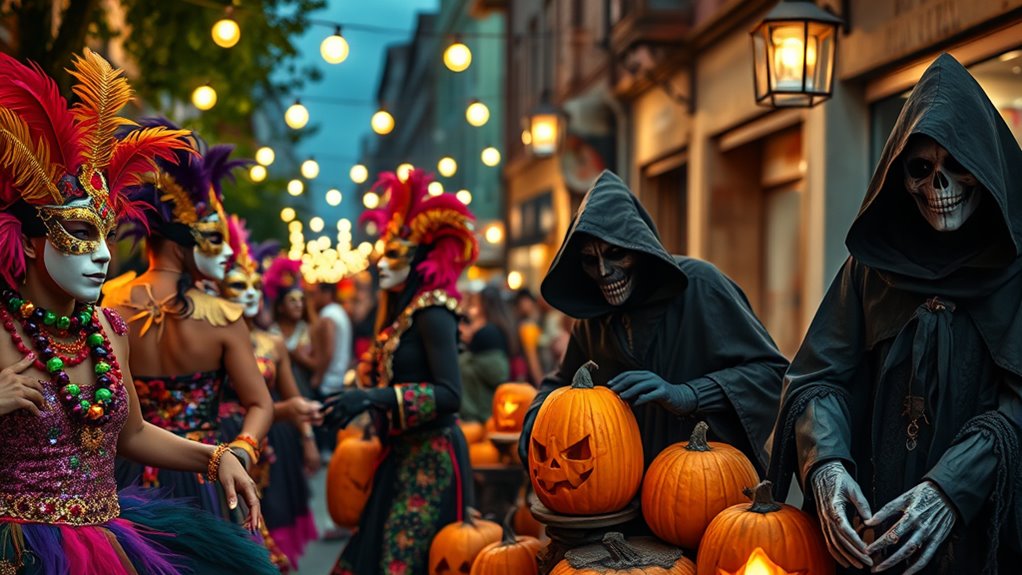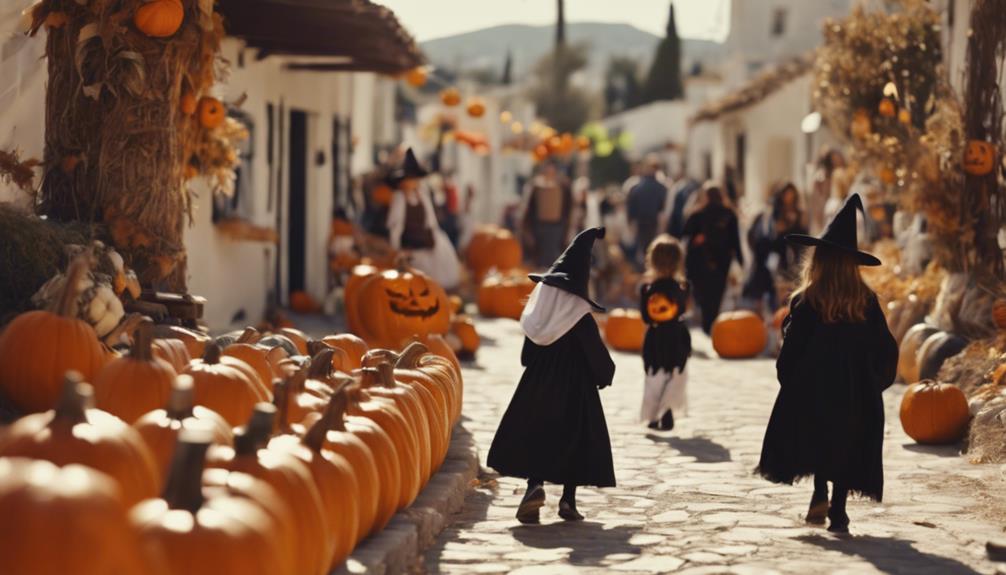Carnival and Halloween both feature lively costumes, but their traditions differ markedly. Carnival costumes celebrate cultural heritage with vibrant, elaborate designs that often highlight regional craftsmanship and storytelling. In contrast, Halloween costumes focus on individual expression, often inspired by spooky, supernatural, or pop culture themes. Carnival costumes symbolize freedom and community spirit, while Halloween outfits evoke fears, fantasies, or personal interests. Exploring these differences further reveals how each celebration uniquely reflects its cultural roots and creative practices.
Key Takeaways
- Carnival costumes emphasize cultural storytelling, grandeur, and regional craftsmanship, while Halloween costumes focus on individual fantasy, fear, and pop culture themes.
- Masks in Carnival symbolize social freedom and heritage, whereas Halloween masks often evoke supernatural fears or iconic characters.
- Carnival costumes are traditionally vibrant, elaborate, and regionally significant, contrasting with Halloween’s often spooky, creative, and fantasy-inspired outfits.
- The purpose of Carnival costumes is to celebrate community and history, while Halloween costumes challenge norms and evoke emotion through imaginative themes.
- Carnival’s costume traditions stem from pagan and Christian roots emphasizing cultural identity, while Halloween’s derive from Celtic and Christian influences centered on the supernatural.

Have you ever wondered how Carnival and Halloween compare? Both celebrations are famous for their vibrant costumes, but their roots and meanings couldn’t be more different. Understanding their cultural origins and the symbolism behind their costumes helps you see why they’re so unique. Carnival’s origins trace back to European pagan festivals, like the pre-Lenten festivities in Italy and France, which celebrated the end of winter and prepared people for fasting. Over time, these festivities blended with Christian traditions, transforming into lively parades featuring elaborate masks and costumes. These costumes often symbolize freedom, disguise, or social commentary, allowing wearers to shed their everyday identities and embrace a temporary world of fantasy. The masks and costumes serve as a form of expression, sometimes rooted in historical or mythological figures, representing cultural heritage and community spirit. Additionally, the use of masks in Carnival has historically allowed individuals to transcend social roles and express collective identity.
Halloween, on the other hand, has roots in ancient Celtic festivals, particularly Samhain, which marked the end of the harvest season and the beginning of winter. It was believed that during Samhain, the boundary between the living and the dead blurred, so people wore costumes—often frightening or supernatural—to ward off spirits or disguise themselves from wandering ghosts. Over centuries, Halloween incorporated elements from Christian traditions, like All Hallows’ Eve, which honored saints and the departed. Today, costumes on Halloween often symbolize fears, supernatural entities, or pop culture icons. You’ll see witches, vampires, zombies, and superheroes—costumes that evoke emotion, challenge norms, or serve as playful representations of fantasy. These outfits aren’t just for fun; they carry symbolism rooted in the desire to confront fears or embrace imagination.
While Carnival costumes tend to emphasize grandeur, color, and cultural storytelling, Halloween costumes often focus on creating a spooky or fantastical persona. Carnival costumes are typically designed to showcase regional craftsmanship, historical significance, or social commentary, with a strong emphasis on tradition and community identity. In contrast, Halloween costumes lean toward individual expression, often inspired by popular media, horror themes, or personal interests. Yet, both celebrations use costumes as a way to escape the ordinary, whether through the historic symbolism of masks in Carnival or the playful fright of Halloween. Ultimately, these traditions reflect different cultural perspectives on identity, celebration, and storytelling—making each festival a fascinating expression of human creativity and history.
Frequently Asked Questions
How Do Costume Choices Reflect Cultural Heritage?
When you choose a costume, you express cultural symbolism and pay homage to your heritage. Your choices often reflect historical influences, showcasing stories, beliefs, or traditions passed down through generations. By wearing specific patterns, colors, or symbols, you connect with your cultural roots and share that identity with others. This act of dressing up allows you to celebrate your background while preserving important aspects of your cultural history.
Are There Regional Variations in Costume Styles?
You’ll notice regional styles greatly influence costume diversity, giving each area its unique flair. In some regions, costumes incorporate traditional patterns and symbols, while others favor modern or eclectic designs. This variation reflects local culture, history, and climate, making your costume choices more meaningful and authentic. Embracing regional styles helps you celebrate the diversity of costume traditions, highlighting how cultural influences shape what people wear during festive occasions.
What Are the Environmental Impacts of Costumes?
Did you know that Americans throw away 2,000 tons of Halloween costumes each year? The environmental impacts are significant, but you can help. By choosing costumes made from sustainable materials, you reduce waste and lessen pollution. Opting for eco-friendly options promotes waste reduction and supports a healthier planet. Your choices make a difference, ensuring these festive traditions don’t come at the environment’s expense.
How Do Costume Traditions Influence Societal Norms?
You might not realize it, but costume traditions shape societal norms by reinforcing cultural identity and influencing social conformity. When you dress up for events, you participate in shared symbols and styles that reflect collective values. These traditions help you connect with your community, fostering a sense of belonging and identity. At the same time, they can encourage conformity, as people often imitate popular or accepted costumes to fit in and show allegiance to societal expectations.
Are There Specific Safety Considerations for Costumes?
When choosing a costume, you should prioritize safety by considering mask safety and visibility concerns. Make sure masks fit well without blocking your view, and opt for breathable materials to prevent overheating. Add reflective elements or bright colors for better visibility, especially at night. Avoid costumes with sharp edges or loose parts that could cause trips or injuries. By taking these precautions, you protect yourself and others while enjoying the festivities.
Conclusion
So, as you choose between Carnival’s vibrant chaos and Halloween’s spooky disguise, remember—both celebrate transformation, yet only one promises a night where you can truly hide behind your mask. Ironically, in trying to stand out, you might just blend into the shadows. Whether you dance or dash in fear, these traditions remind us that sometimes, the costume is more real than the person underneath. After all, isn’t hiding just another kind of revealing?









